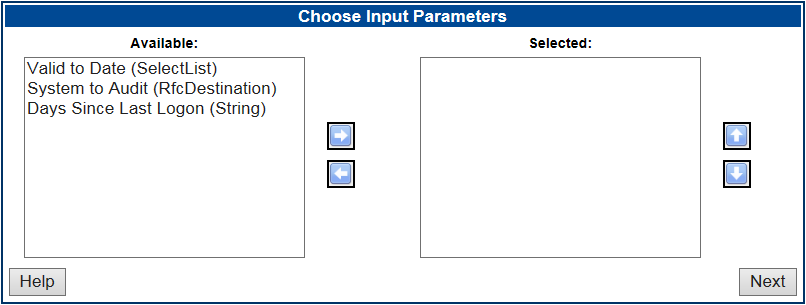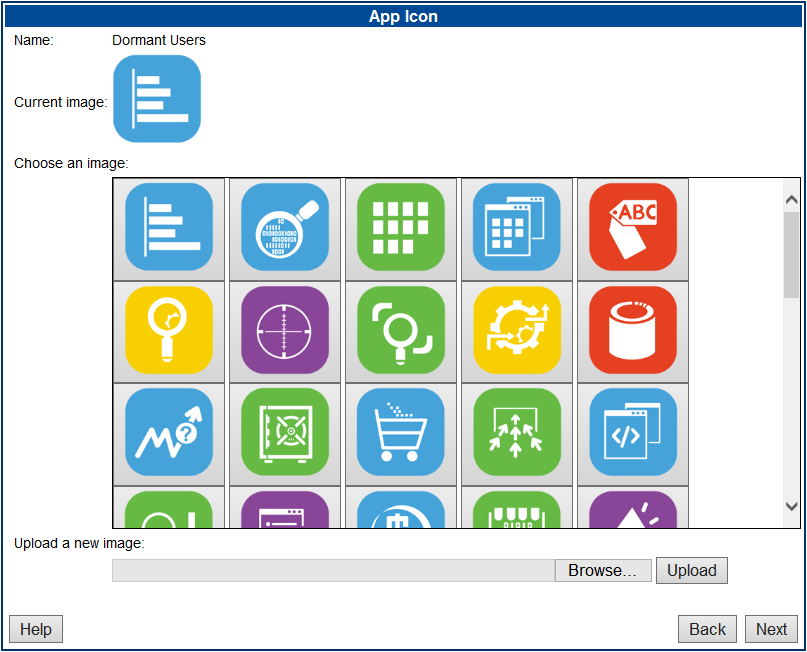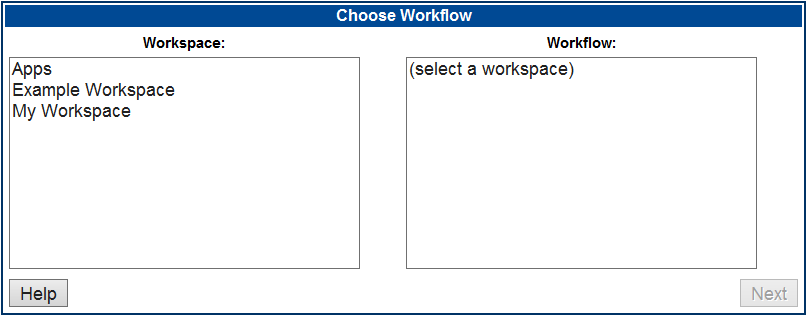Register Workflow as App Wizard
The Register Workflow as App Wizard allows a workflow to be registered as an App, or the workflow associated with an existing App to be replaced with a new workflow. Apps allow the input parameters for a workflow to be set using a form-based interface.
Before running the Wizard, note that the workflow to be registered as an App, or the workflow that will update an existing App must have uniquely named input parameters and uniquely named output (terminal) datasets. If the workflow to be registered as an App uses the Run Workflow action to call another workflow, only the calling workflow needs to be registered as an App.
Registering a Workflow as an App
If you have LiveCompare Editor privileges, start the Register Workflow as App Wizard by selecting a workflow in the LiveCompare hierarchy and choosing ‘Register as App’ from its context menu. The following screens are displayed:
Choose Input Parameters
This screen allows you to specify the input parameters to be displayed in the App by selecting them from a list of the workflow’s parameter nodes. AAQ Select List, Boolean, External Data Source, Float, IMG Select List, Integer, Pair List, RFC Destination, Select List, String, String List, String Multiline, Table and Test Repository Parameters are supported by the Wizard.

Note that if a String List is used as an input parameter for an App, each item in the String List should occupy a single line. Multi-line String List elements are not supported.
Select one or more parameters from the ‘Available’
list box, and click  to add then to the ‘Selected’ list box. Use Ctrl+Click
to highlight multiple items, or Shift+Click to highlight a range of items.
Use the
to add then to the ‘Selected’ list box. Use Ctrl+Click
to highlight multiple items, or Shift+Click to highlight a range of items.
Use the  and
and  buttons to change the position of highlighted parameters in
the ‘Selected’ list box. The order of these parameters will be reflected
in variants that are created for the App. Use the
buttons to change the position of highlighted parameters in
the ‘Selected’ list box. The order of these parameters will be reflected
in variants that are created for the App. Use the  button to remove highlighted items from the
‘Selected’ list box.
button to remove highlighted items from the
‘Selected’ list box.
Click ‘Next’ to continue.
Input Parameters
This screen allows you to specify the widgets to be used in the App’s user interface to enter values for Boolean, Float, Integer and String parameters.

The following controls are available:
| Widget | Description |
|---|---|
| Default | The default control for each parameter type. For example, the default control for a String parameter is a simple entry field. |
| Date | This control includes a calendar control which allows a date to be set as the value for a String parameter. The settings for this control allow the date format to be specified. |
| Mask | This control allows a character mask to be used to specify the format of the input string set as the value for a Float, Integer or String parameter. The settings for this string allow a character mask and a default field value to be specified. |
| Slider | A slider control which allows the value for an Integer or Float parameter to be set. The settings for this control allow the maximum value, minimum value and increment to be specified. When an App run or saved, values entered manually into the control are updated appropriately if they do not confirm to the maximum value, minimum value and increment settings. |
| Switch | A switch control which may be turned on or off to set the value of a Boolean parameter. The settings for this control allow the ‘true’ and ‘false’ values that are displayed in the switch control to be specified. |
| Value List | A list box or drop-down list which allows the value for an Integer, Float or String parameter to be set by selecting an item from a list. The settings for this control allow a set of list values to be specified, as well as the length of the value list control. |
Click the ‘Change’ button in the ‘Widget’ column for Boolean, Float, Integer and String parameters to modify the parameter’s rich user interface control. When you have made the required changes, click ‘Next’ to continue.
Choose Output Parameter
This screen allows you to select an output parameter which will be used to display the workflow’s results in the App. A single terminal String dataset may be selected. In the workflow that is registered as an App, this would normally be set to the URL of a generated report.

Select the radio button next to the String dataset that will contain the workflow’s results, and click ‘Next’ to continue.
App Properties
This screen allows you to select an App’s name and description, and to assign the App to one or more DevOps categories. These details are displayed for the App in the Consumer interface’s Apps screen.

Complete the ‘Name’ and ‘Description’ fields. By default the ‘Name’ field is set to the name of the App’s associated workflow. The following characters may not be used in the ‘Name’ field: / \ : * ? " < > | +.
Assign the app to one or more DevOps categories by selecting values from the Categories field. The Development, Testing, InfoSec and Operations DevOps categories are available. If required, click ‘X’ to remove a category from your selections.
App Icon
This screen allows you to select an icon to be displayed for the App in the Consumer interface’s Apps screen, and the Studio interface’s App Store.

Select a graphic to be displayed for the App from the list of sample images. The first image is selected by default. Alternatively, click ‘Browse…’ to browse for your own image file, then click ‘Upload’ to upload it. Uploaded graphics are added to the list of sample images.
Click ‘Next’ to continue.
Select Projects
If LiveCompare is project-controlled, the following screen allows you to add the App to one or more projects to which you have access.

Select the projects to be added to the App. Click ‘Select All’ to select all projects, or ‘Select None’ to select no projects. Note that the App is always added to the current project, so the current project may not be deselected. Click ‘Next’ to continue.
Finish - Confirm Register App
This screen displays the App’s name and description.

Click ‘Finish’ to register the workflow as an App, or ‘Back’ to make any changes.
When the Register Workflow as App Wizard has completed, the App will be displayed in the Consumer interface’s Apps screen and in the App Store accessed from the Studio interface. If LiveCompare is project-controlled, the App is added to the user’s current project.
Replacing an App’s Associated Workflow
If you have LiveCompare Editor privileges, the workflow associated with an existing App may be replaced by carrying out the following steps:
- Select the App Store folder in the LiveCompare hierarchy to display the App Store screen.
- Click a link in the ‘App’ column to display the Edit App screen.
- Click ‘Replace Workflow’. The following screen is displayed.

- Select a workspace, then select the replacement workflow. Note that if LiveCompare is project-controlled, only the workspaces in the currently selected project are displayed.
- Click ‘Next’ to proceed to the Register Workflow as App Wizard screens described in the Registering a Workflow as an App section.